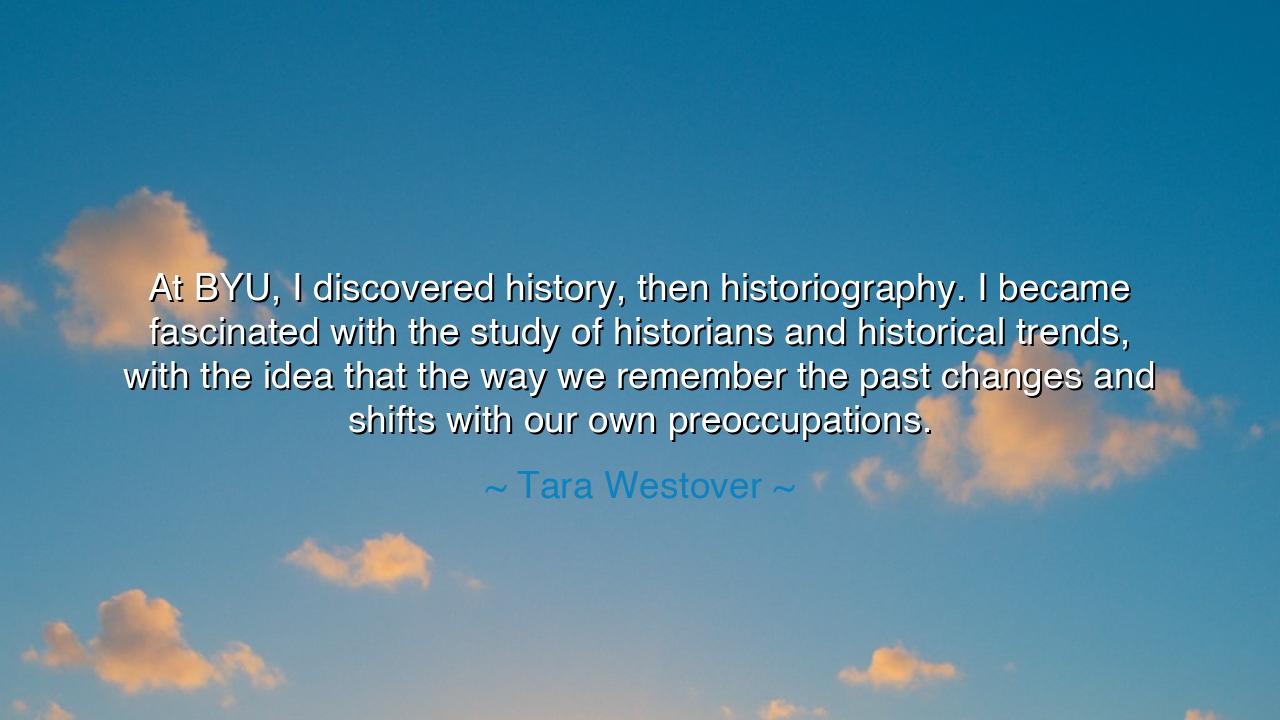
At BYU, I discovered history, then historiography. I became
At BYU, I discovered history, then historiography. I became fascinated with the study of historians and historical trends, with the idea that the way we remember the past changes and shifts with our own preoccupations.






In the words of Tara Westover, a voice born from silence and self-discovery, we find the deep awakening of a mind meeting its own reflection: “At BYU, I discovered history, then historiography. I became fascinated with the study of historians and historical trends, with the idea that the way we remember the past changes and shifts with our own preoccupations.” This is not a mere academic confession; it is the testimony of a soul discovering that truth is not fixed in stone but shaped by the eyes that behold it. To discover history is to learn the stories of the world; to discover historiography is to learn the story of those stories — the shifting sands of how humans, through time, choose to remember.
The origin of these words lies in Westover’s own journey from darkness into knowledge. Raised in isolation in the mountains of Idaho, denied the basic touch of formal education, she entered Brigham Young University with a mind unshaped by textbooks or classrooms, but rich with the hunger to understand. For her, history was not a series of dry dates and decrees; it was revelation. She came to see that history is not one voice, but a chorus of perspectives — that every generation retells the past in its own image. What she found in historiography, the study of how history itself is written, was the deeper truth: that memory, like water, flows through the landscape of human desire and fear, taking the shape of its container.
To realize this is to glimpse the living heart of civilization. The ancients, too, knew that history was not only record but reflection. The Greeks spoke of Clio, the muse of history, not as a scribe, but as an artist — one who painted the deeds of mortals through the colors of time. The philosopher Herodotus, often called the father of history, did not simply recount battles; he pondered the motives and moral lessons within them. Yet, as Westover reminds us, what each historian chooses to see or omit reveals not just the past, but the spirit of their own age. The Romans glorified empire; the Enlightenment celebrated reason; modern historians wrestle with justice and identity. Thus, history is not merely what happened, but what humanity chooses to remember.
Consider, for instance, the story of Joan of Arc. In her own century, she was condemned as a heretic, a witch, a danger to order. A hundred years later, she was remembered as a saint and martyr, and centuries after that, as a feminist icon and symbol of courage. The events did not change — but the lens of remembrance did. Each age saw in her what it needed: a warning, a miracle, or a mirror of its own ideals. This is what Westover discovered — that our preoccupations shape the way we tell stories, and through those stories, we shape the meaning of the world.
In this revelation lies both beauty and danger. For if the past is malleable in memory, then truth must be guarded with humility and care. Westover’s fascination is not passive wonder but moral awakening: an understanding that we, too, participate in the making of history — not only through deeds, but through remembrance. Every historian, every teacher, every citizen who speaks of the past adds or removes a thread from the great tapestry of human memory. Thus, the act of studying historiography is an act of vigilance — a recognition that truth must be pursued with both passion and doubt, lest we mistake our reflection for reality.
Her insight calls to us in this age of information, when narratives rise and fall like waves upon the sea. We live in a time where the memory of humanity can be rewritten in seconds — where opinions masquerade as records, and history bends under the weight of ideology. To remember wisely, as Westover learned, is to look not only at events, but at the storytellers themselves — to ask who is speaking, why they speak, and for whom their words are meant. This is the discipline of the historian of historians, the one who seeks not only knowledge, but understanding.
Therefore, my listener, take this lesson from Tara Westover’s awakening: seek truth, but seek it humbly. Know that every history you read, every story you tell, is born of human vision and limitation. Do not cling to a single version of the past, for the truth is not a monolith, but a mosaic — a thousand shards of memory reflecting the light from different angles. To study history is to learn the world; to study historiography is to learn yourself — your biases, your beliefs, your place in the river of time.
And so, live as both student and guardian of memory. Question the stories handed down to you. Listen to the voices forgotten by the loud. Let your curiosity be your compass, your conscience your guide. For as Tara Westover teaches, history is not only a record of what has been — it is a living mirror of who we are. And when we understand how our preoccupations shape our remembering, we begin not only to see the past more clearly — we begin, perhaps for the first time, to shape a more honest future.






AAdministratorAdministrator
Welcome, honored guests. Please leave a comment, we will respond soon